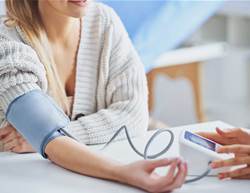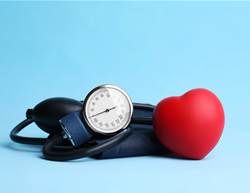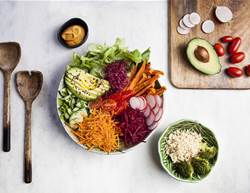Eye-opening health stat: around a quarter of Australian adults (roughly 4.8 million people) are thought to have high blood pressure. This excess force of blood pushing against artery walls can damage blood vessels and ultimately trigger heart attack, stroke or kidney damage. But there’s good news: it’s often reversible with easy lifestyle tweaks. Become the boss of your BP with this expert advice.
Know your numbers
Fact: knowing you blood pressure is as valuable as knowing your bank balance. Not sure what those readings mean? Of the two figures used to record it, the larger (known as systolic —the smaller is diastolic) tends to be of most interest, explains Professor Tom Marwick, Director of Baker IDI Heart and Diabetes Institute. “A normal reading is around 120/80 mmHg. If the systolic goes up to 140, you’d look at lifestyle changes, any higher—150, 160—is when your doctor may look at medication.” Your GP will take your BP at appointments.
Jump on the scales
Your kilo-count is one of the most controllable factors when it comes to higher-than-normal BP. One review of research by the Institute for Quality and Efficacy in Cologne, Germany, found people who lost just 4kg lowered their systolic pressure by 4.5 mmHg and diastolic by 3 mmHg. Not bad! “Often a relatively small weight reduction of 5–10%, or a few kilos, makes a big difference,” says Marwick. Healthy weight, healthy BP. Easy.
Put down the salt shaker
Sure, it adds flavour, but know this: “Salt is a huge driver of high blood pressure,” warns Marwick. Avoid adding it to meals, bypass processed food and start getting familiar with nutrition labels. Oh, and speaking of dinner: enjoy sweet potato, avocado and yogurt for plenty of natural, pressure-lowering potassium.
Cut back on wine time
A drink a day is likely fine, but three? That raises BP even in healthy people. If you’re a serious wine lover, take advice from your healthcare professional and cut back slowly over two weeks to avoid BP spikes that can happen when quitting cold turkey. It’ll be worth it: going from heavy to moderate drinking can lower systolic blood pressure by 2 to 4 mmHg. Noted!
Get your sweat on
In a new US study, people living in ‘walkable’ neighbourhoods— where running errands on foot was convenient—were less likely to have high blood pressure than those in areas where driving was the easiest option. “Physical activity has a beneficial impact on blood vessels and circulation,” adds Marwick. Aim for at least 30 minutes of moderate activity every day.
Soak up some sunshine
More than just a mood enhancer, UV light alters levels of nitric oxide in skin and blood, lowering BP. Japanese research into shinrin-yoku or “forest bathing” found time in nature also lowers blood pressure, stress hormones and heart rate. Another natural fix? Deep breathing. Do it daily with relaxing exercises on the Breathing Zone app ($6.99, iTunes), or schedule a weekly yoga class.
Look to prescription meds
If lifestyle changes don’t cut it, your GP might offer medication, based on factors such as your age and health history. “Common types include ACE inhibitors and calcium channel blockers, which help to relax your arteries,” says Marwick.
Promising probiotics
Pass the yoghurt? Maybe. In an analysis of nine studies, Australian researchers discovered that getting good bacteria from food (such as yoghurt) and probiotic pills (go for multiple strains) for more than eight weeks was linked to lower BP. Some of the studies were small, though, so the team concluded more research is still needed. Watch this space!










